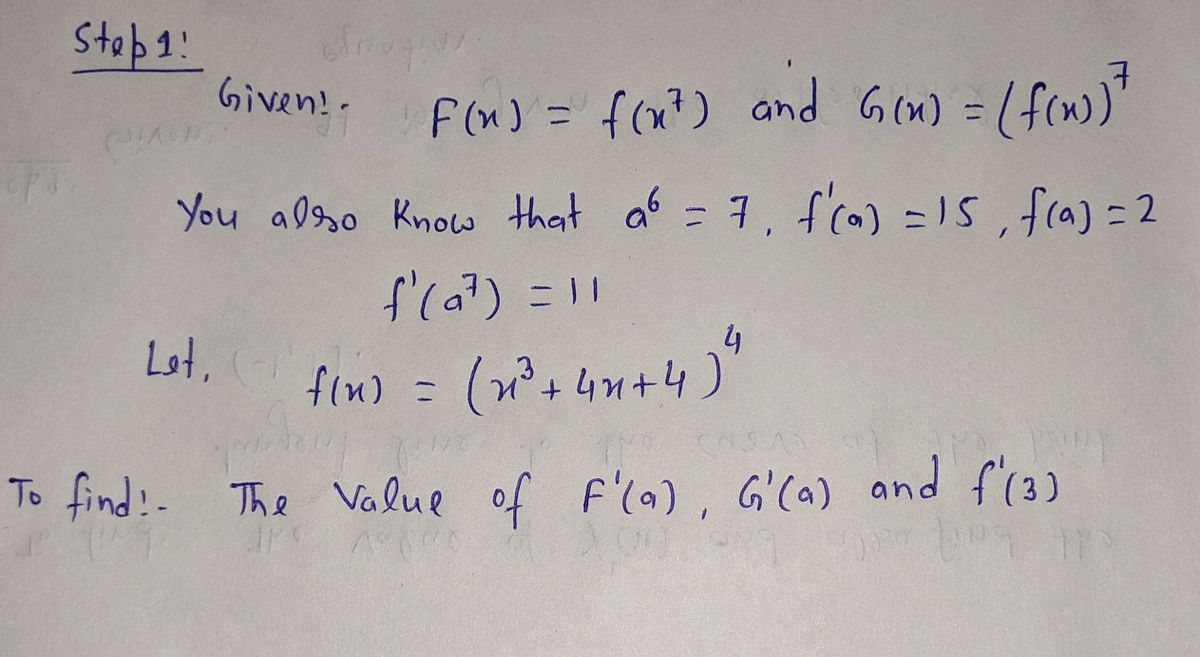Calculus: Early Transcendentals
8th Edition
ISBN:9781285741550
Author:James Stewart
Publisher:James Stewart
Chapter1: Functions And Models
Section: Chapter Questions
Problem 1RCC: (a) What is a function? What are its domain and range? (b) What is the graph of a function? (c) How...
Related questions
Question

Transcribed Image Text:Let \( F(x) = f(x^7) \) and \( G(x) = (f(x))^7 \).
You also know that \( a^6 = 7 \), \( f(a) = 2 \), \( f'(a) = 15 \), \( f'(a^7) = 11 \).
Then \( F'(a) = \boxed{} \) and \( G'(a) = \boxed{} \).
![The image presents a problem involving calculus and differentiation, specifically using the chain rule.
**Problem Statement:**
Let
\[ f(x) = (x^3 + 4x + 4)^4 \]
Calculate the derivative \( f'(x) \).
**Solution Provided:**
\[ f'(x) = 4(x^3 + 4x + 4)^3 (3x^2 + 4) \]
This expression uses the chain rule to find the derivative of the function. The outer function is \((u)^4\) where \(u = x^3 + 4x + 4\), and the inner function is \(x^3 + 4x + 4\).
To further explain:
- The derivative of \((u)^4\) with respect to \(u\) is \(4(u)^3\).
- The derivative of the inner function \(x^3 + 4x + 4\) with respect to \(x\) is \(3x^2 + 4\).
Thus, multiplying these derivatives together gives the total derivative, demonstrating the application of the chain rule.
**Next Task:**
Calculate \( f'(3) \), which involves substituting \( x = 3 \) into the derivative expression.](/v2/_next/image?url=https%3A%2F%2Fcontent.bartleby.com%2Fqna-images%2Fquestion%2F3e51674d-3d29-4cb4-94ad-529601d10286%2F23841221-738b-45c9-8c4d-4faa3d299803%2F0p0fran_processed.png&w=3840&q=75)
Transcribed Image Text:The image presents a problem involving calculus and differentiation, specifically using the chain rule.
**Problem Statement:**
Let
\[ f(x) = (x^3 + 4x + 4)^4 \]
Calculate the derivative \( f'(x) \).
**Solution Provided:**
\[ f'(x) = 4(x^3 + 4x + 4)^3 (3x^2 + 4) \]
This expression uses the chain rule to find the derivative of the function. The outer function is \((u)^4\) where \(u = x^3 + 4x + 4\), and the inner function is \(x^3 + 4x + 4\).
To further explain:
- The derivative of \((u)^4\) with respect to \(u\) is \(4(u)^3\).
- The derivative of the inner function \(x^3 + 4x + 4\) with respect to \(x\) is \(3x^2 + 4\).
Thus, multiplying these derivatives together gives the total derivative, demonstrating the application of the chain rule.
**Next Task:**
Calculate \( f'(3) \), which involves substituting \( x = 3 \) into the derivative expression.
Expert Solution
Step 1

Step by step
Solved in 2 steps with 2 images

Recommended textbooks for you

Calculus: Early Transcendentals
Calculus
ISBN:
9781285741550
Author:
James Stewart
Publisher:
Cengage Learning

Thomas' Calculus (14th Edition)
Calculus
ISBN:
9780134438986
Author:
Joel R. Hass, Christopher E. Heil, Maurice D. Weir
Publisher:
PEARSON

Calculus: Early Transcendentals (3rd Edition)
Calculus
ISBN:
9780134763644
Author:
William L. Briggs, Lyle Cochran, Bernard Gillett, Eric Schulz
Publisher:
PEARSON

Calculus: Early Transcendentals
Calculus
ISBN:
9781285741550
Author:
James Stewart
Publisher:
Cengage Learning

Thomas' Calculus (14th Edition)
Calculus
ISBN:
9780134438986
Author:
Joel R. Hass, Christopher E. Heil, Maurice D. Weir
Publisher:
PEARSON

Calculus: Early Transcendentals (3rd Edition)
Calculus
ISBN:
9780134763644
Author:
William L. Briggs, Lyle Cochran, Bernard Gillett, Eric Schulz
Publisher:
PEARSON

Calculus: Early Transcendentals
Calculus
ISBN:
9781319050740
Author:
Jon Rogawski, Colin Adams, Robert Franzosa
Publisher:
W. H. Freeman


Calculus: Early Transcendental Functions
Calculus
ISBN:
9781337552516
Author:
Ron Larson, Bruce H. Edwards
Publisher:
Cengage Learning